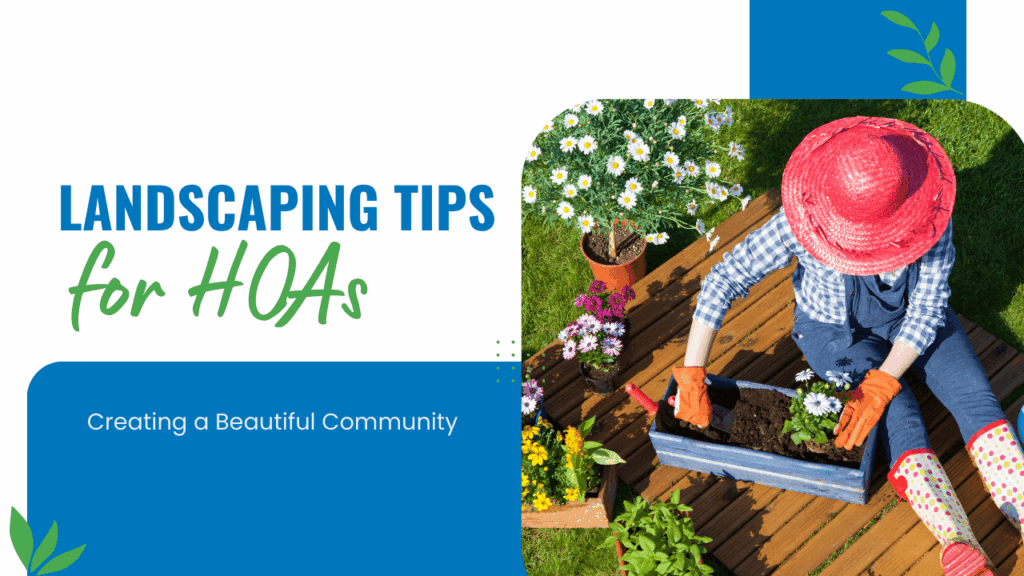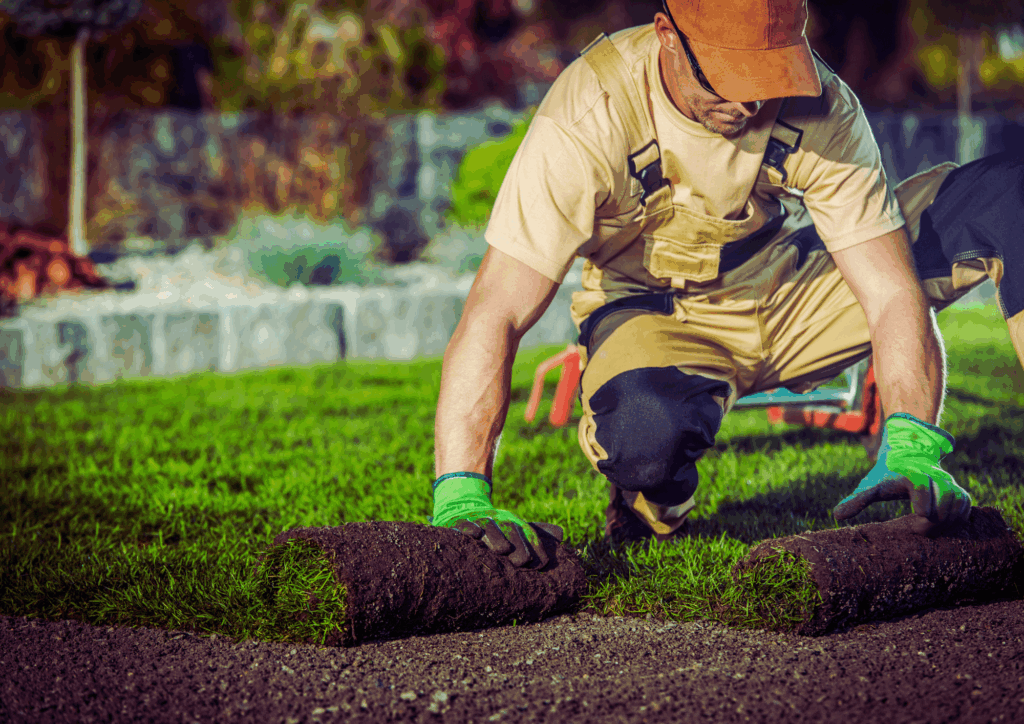
It’s tough to keep property values up in a community that isn’t looking its best.
So, let’s make sure your Winston-Salem HOA is looking its absolute best.
We’re talking about landscaping. More than landscaping, we’re talking about the curb appeal of your community. Is there beauty? Is there a welcoming and inviting vibe? Would someone coming to see a property within your association be impressed by the landscaping they see throughout the neighborhoods?
A Beautiful Community: Why It Matters
The number of residential communities has been growing steadily over the last decade. They’re becoming even more popular in Winston-Salem. So how can you make sure your HOA is competitive?
Landscaping helps.
Beautifully maintained landscapes have a profound impact on the community, affecting everything from property values to the sense of pride that residents feel in their surroundings. While the specific types of landscaping may vary, the overall benefits of thoughtful and consistent landscaping within an HOA are clear and far-reaching.
- Enhancing Curb Appeal and First Impressions
One of the primary reasons landscaping is important in an HOA is its ability to enhance curb appeal. First impressions matter, and when visitors, potential buyers, or even residents themselves enter a community, the appearance of the area can have a lasting impact. Lush greenery, well-maintained lawns, and carefully selected plants and trees create a welcoming environment that signals care and pride. When the landscape is thoughtfully curated, it elevates the overall aesthetic of the entire community, making it more inviting and attractive to everyone.
- Increasing Property Values
In real estate, curb appeal is directly tied to property value. Homes within an HOA that prioritize landscaping are often more valuable than those in neighborhoods where landscaping is neglected or inconsistent. The visual appeal of the community contributes to its overall marketability. For potential buyers, the condition of the landscaping is often a reflection of how well the entire community is managed. A neighborhood with carefully designed landscaping suggests that the HOA is organized, attentive, and committed to maintaining a pleasant living environment, which can directly influence a home’s value.
Landscaping is your community’s opportunity to say something about itself. As an HOA board and leadership team, you want to make sure you’re sending the right message.
- Creating a Sense of Community and Pride
Landscaping within an HOA has the unique ability to instill a sense of pride and ownership among residents. When people live in a neighborhood that prioritizes beautiful, well-kept surroundings, they are more likely to take pride in their own homes and contribute to the maintenance of the area. The collective effort to keep the neighborhood looking its best helps create a strong sense of community, where everyone feels invested in their environment. Over time, this can encourage social interactions, improve neighborly relationships, and enhance the overall quality of life for residents.
- Promoting a Peaceful and Relaxing Environment
A well-maintained landscape can create a calming, peaceful atmosphere within a neighborhood. Green spaces, flowers, and trees not only provide aesthetic beauty but can also offer a natural, soothing backdrop for residents. Whether it’s taking a walk through tree-lined streets or simply sitting on a porch surrounded by colorful blooms, the presence of nature has been shown to reduce stress, improve mood, and contribute to overall well-being. A neighborhood with well-planned landscaping can serve as a sanctuary from the chaos of the outside world, offering residents a peaceful retreat right in their own community.
- Encouraging Environmental Sustainability
Landscaping can also play an important role in environmental sustainability. Thoughtful design and maintenance practices can help reduce water consumption, promote local biodiversity, and even contribute to better air quality. By incorporating native plants or sustainable landscaping practices, an HOA can create an environment that benefits both residents and the planet. This commitment to sustainability not only improves the immediate environment but can also increase the long-term viability of the neighborhood as a whole.
- Building a Lasting Legacy
Landscaping in an HOA can have a lasting impact on the legacy of the community. Over the years, as trees grow and gardens flourish, the neighborhood develops a timeless quality that stands as a testament to the community’s dedication to beautifying their surroundings. Well-maintained landscapes can become a defining feature of the neighborhood, making it a place that residents remember fondly long after they’ve moved away. A beautifully landscaped community can continue to attract new residents, maintaining its desirability for years to come.
Make This a Priority

In an HOA, landscaping is far more than a mere aesthetic choice; it’s an essential aspect of creating a thriving, attractive, and well-functioning community. From enhancing curb appeal and boosting property values to creating a sense of community pride and promoting sustainability, the benefits of good landscaping are clear. Ultimately, a beautifully landscaped HOA is a reflection of the values and priorities of the residents and the management, contributing to a positive living environment for everyone involved. When properly maintained, the landscape becomes more than just a backdrop; it becomes an integral part of the community’s identity and success.
Need tips?
We’ve got you.
Landscaping Tips Your Winston-Salem HOA Can Implement Now
If you’re a board member at your Winston-Salem HOA, you understand the importance of maintaining and improving the appearance of your community. This is probably why you decided to run for a leadership position. You care.
And you know that a well-landscaped neighborhood not only adds to the aesthetic appeal but also enhances property values, creates a sense of pride among residents, and creates a welcoming environment.
Landscaping can be a huge undertaking, especially if your community is large, has a lot of green space, or needs to work with some specific challenges. Managing shared spaces isn’t always easy, either. Most of your residents will likely love how things look, but you’ll always have a handful of complainers, even after you’ve made some pretty substantive changes.
We have found, through our experience as HOA management partners for many associations in Winston-Salem, that with a thoughtful and sustainable approach, you can create a community that stands out for all the right reasons. These are some of the tips that have worked best for our communities in the past.
- Develop a Comprehensive Landscaping Plan
 The first and potentially most important step in transforming and improving the landscape of your community is to develop a comprehensive plan that reflects the needs and preferences of your residents, while also staying within the HOA’s budget.
The first and potentially most important step in transforming and improving the landscape of your community is to develop a comprehensive plan that reflects the needs and preferences of your residents, while also staying within the HOA’s budget.
If you have never created a landscaping plan before, it should address various aspects such as:
| Common areas
Entrances, clubhouses, parks, and other shared spaces. |
Street frontage
Trees, shrubs, and flowers that line the roads. |
| Individual yards
Do your owners have private yards? Landscaping guidelines for private homes that still complement the overall look of the neighborhood. |
Sustainability
Consideration of native plants, water conservation, and eco-friendly practices. |
By developing a cohesive plan that incorporates these elements, the HOA board can ensure that the entire community has a unified and appealing aesthetic.
- Prioritize Curb Appeal
The first impression of any neighborhood is important, and for a lot of reasons. The curb appeal of common areas and entranceways sets the tone for visitors and potential buyers. Here are a few tips to enhance the curb appeal of your HOA community:
| Create a focal point at the entrance. Install attractive signage and use landscaping elements such as flowers, trees, or decorative stones around the entrance gates. A well-designed sign combined with colorful flower beds or shrubs can make a lasting impression. You want to let people know where they are, and you want the introduction to be memorable. |
| Use low-maintenance plants. Choose plants that are easy to maintain and suited to the climate in your area. Perennials are a great option because they come back year after year, reducing the need for constant replanting. |
| Add seasonal color. Seasonal flowers such as tulips, daffodils, and marigolds can bring color and vibrancy to your community throughout the year. Be sure to rotate plants seasonally to keep the landscape fresh and interesting. |
- Implement Water-Smart Landscaping
Even in Winston-Salem, where we get enough rain during the wet seasons, water conservation is still more important than ever. An HOA’s landscaping can play a big role in reducing water usage and maintaining an environmentally conscious community. Here are a few ways to implement water-smart landscaping:
- Use drought-tolerant plants. Choose plants that thrive in your local climate and require minimal water once established. Native plants are particularly well-suited for this, as they are adapted to the local environment and require less water and maintenance.
- Incorporate xeriscaping. This landscaping technique involves using drought-tolerant plants, rocks, and mulch to create beautiful, water-efficient landscapes. Xeriscaping can dramatically reduce water usage while still offering an attractive design. It’s growing in popularity and appeal. It’s also a lot more low-maintenance than a green, lush grass
- Install an efficient irrigation system. Automatic irrigation systems with rain sensors and smart controllers ensure that water is used efficiently, minimizing waste and maximizing the health of your plants. Consider drip irrigation for flower beds and shrubs to target the root zones more effectively.
- Focus on Sustainable Practices
Sustainability is an increasingly important consideration for homeowners and communities. Incorporating sustainable landscaping practices not only benefits the environment but also can lower long-term maintenance costs. Some sustainable landscaping tips include:
- Use organic mulches. Mulch helps to retain moisture in the soil, prevents weeds, and adds a neat, finished look to flower beds. Organic mulches, such as shredded bark or compost, improve soil health as they decompose over time.
- Plant trees for shade. Trees provide natural shade, which can reduce the need for air conditioning in the summer and lower energy costs for residents. Strategic tree planting around common areas, parks, and pathways can also create a cool and pleasant atmosphere for outdoor activities. Pay attention to tree health, too. If you have trees that are sick or dying, make sure you get an expert to evaluate them.
- Encourage composting. Promote composting in your community, either through shared composting bins in common areas or by educating residents on how they can compost at home. Composting reduces waste and provides rich, nutrient-dense soil that can be used for landscaping.
- Embrace Pollinator-Friendly Landscaping
You want a community that’s pretty, and you want your homeowners to enjoy being outside. Pollinators such as bees, butterflies, and hummingbirds play a crucial role in our ecosystem, and creating a pollinator-friendly environment is a great way to support local wildlife. Here are some ways to make your community more inviting to pollinators:
| Plant native flowering species
Native plants attract local pollinators because they provide the right types of nectar and pollen. Flowers like coneflowers, black-eyed Susans, and milkweed are known for attracting butterflies, while bee balm and lavender are favored by bees. |
Create pollinator corridors
Consider planting wildflower meadows, flower borders, and shrubs that create a continuous habitat for pollinators to move through. Pollinator corridors help connect fragmented habitats and provide a safe path for bees, butterflies, and other species. |
Avoid pesticides
Pesticides can harm pollinators, so it’s important to minimize or eliminate their use in the community’s landscaping. Instead, focus on integrated pest management practices, such as using natural predators to control pests or encouraging beneficial insects like ladybugs. |
- Keep Landscaping Maintenance Cost-Effective
 While landscaping is an investment, keeping the costs under control is important for any HOA. You probably don’t have a lot of extra room in the budget for a major landscaping overhaul. That’s okay. Some of the best changes and updates can be cost-effective. We also have some good ideas for balancing beauty and cost-effectiveness:
While landscaping is an investment, keeping the costs under control is important for any HOA. You probably don’t have a lot of extra room in the budget for a major landscaping overhaul. That’s okay. Some of the best changes and updates can be cost-effective. We also have some good ideas for balancing beauty and cost-effectiveness:
- Adopt a low-maintenance design. When planning the community’s landscaping, focus on elements that are easy to maintain. For example, planting perennials instead of annuals can save on replanting costs. Use ground covers like clover or native grasses instead of constantly mowing lawns.
- Use turf alternatives. Lawn grass often requires a lot of water, fertilizer, and mowing. Turf alternatives such as groundcovers, gravel, or artificial turf in certain areas can reduce both maintenance time and costs.
- Partner with local landscapers. Partnering with a local landscaping company that understands your community’s needs can help streamline maintenance and ensure a higher quality of work at a competitive price. Get multiple quotes, and ensure the contractor is experienced with sustainable practices and water-wise solutions. We have some excellent relationships in place with local landscaping services, so don’t hesitate to reach out to the Capstone Realty team when you’re looking for direction and inspiration.
- Involve Residents in Landscaping Projects
Engaging the residents in landscaping initiatives can promote community pride and ensure that the design reflects the preferences of the people who live there. How can you include residents? Consider some of these opportunities.
- Host community planting days. Organize volunteer events where residents can help plant flowers, shrubs, or trees in common areas. Not only does this beautify the neighborhood, but it also fosters a sense of community and ownership. This will be a good opportunity to build some community, and you might be surprised at how many people are excited to get involved. Make sure the HOA board has a presence at these events.
- Create garden clubs or committees. Form a garden club or landscaping committee where residents can provide input on the community’s landscape design and maintenance. This gives homeowners a chance to contribute ideas and be actively involved in enhancing the neighborhood.
- Survey residents. Get an idea of what kind of interest is out there around initiatives such as these. Periodically survey residents to gather feedback on landscaping preferences, maintenance satisfaction, and suggestions for improvement. Understanding what residents want can help the HOA board make better-informed decisions.
Stay Flexible and Adaptable

Things don’t have to look or be one certain way. And when it comes to landscaping, we recommend flexibility and adaptability.
Landscaping is a dynamic aspect of any community. As seasons change, plants grow, and new landscaping trends emerge, the HOA should be open to revising its landscaping plan over time. Regularly assess the effectiveness of the existing landscaping efforts and make adjustments as needed. Whether that means adding new plant varieties, redesigning flower beds, or implementing sustainable practices like rain gardens, flexibility will ensure that the community’s landscaping stays vibrant and relevant.
Landscaping is one of the most impactful ways to enhance the beauty and value of an HOA community. By focusing on cohesive design, sustainability, water efficiency, and involving residents, you can create a landscape that is not only visually appealing but also eco-friendly and easy to maintain. The tips we have shared in this blog post are based on our experience as community HOA managers. We offer a starting point for transforming your community’s outdoor spaces into inviting, beautiful, and functional environments for everyone to enjoy.
When you’re interested in our professional advice on landscaping and curb appeal for your Winston-Salem HOA, contact us at Capstone Realty Consultants. We have a record of success in making cost-effective, meaningful changes that can provide more beauty and harmony to your community.
